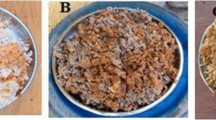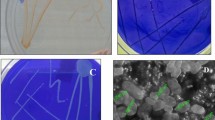Abstract
Among several yeasts isolated from dried flowers of Woodfordia fruticosa, Pichia anomala produced a high titre of cell-bound phytase. The optimization of fermentation variables led to formulation of media and selection of cultural variables that supported enhanced phytase production. The enzyme productivity was very high in fed batch fermentation in air-lift fermentor as compared to that in stirred tank fermentor. Amelioration in the cell-bound phytase activity was observed when yeast cells were permeabilized with Triton-X-100. The enzyme is thermostable and acid stable with broad substrate specificity, the characteristics that are desirable for enzymes to be used in the animal feed industry. The phytase-encoding gene was cloned and sequenced. The 3D structure of the enzyme was proposed by comparative modeling using phytase of Debaryomyces occidentalis (50% sequence identity) as template. When broiler chicks, and fresh water and marine fishes were fed with the feed supplemented with yeast biomass containing phytase, improvement in growth and phosphorus retention, and decrease in the excretion of phosphorus in the faeces were recorded. The cell-bound phytase of P. anomala could effectively dephytinize wheat flour and soymilk.

Similar content being viewed by others
References
da Silva LG, Trugo LC, Terzi SC, Couri S (2005) Low phytate lupin flour based biomass obtained by fermentation with a mutant of Aspergillus niger. Process Biochem 40:951–954. doi:10.1016/j.procbio.2004.02.016
Harland BF, Morris ER (1995) Phytate: a good or a bad food component. Nutr Res 15(5):733–754
Hassan S, Altaff K, Satyanarayana T (2009) Use of soybean meal supplemented with cell bound phytase for replacement. Pak J Nutr 8(4):341–344. doi:10.3923/pjn.2009.341.344
Kaur P, Satyanarayana T (2005) Production of cell-bound phytase by Pichia anomala in an economical cane molasses medium: optimization using statistical tools. Process Biochem 40(9):3095–3102. doi:10.1016/j.procbio.2005.03.059
Kaur P, Satyanarayana T (2010) Improvement in cell-bound phytase activity of Pichia anomala by permeabilization and applicability of permeabilized cells in soymilk dephytinization. J Appl Microbiol 108:2041–2049. doi:10.1111/j.1365-2672.2009.04607
Kaur P, Kunze G, Satyanarayana T (2007) Yeast phytases: present scenario and future perspectives. Crit Rev Biotechnol 27:93–109. doi:10.1080/07388550701334519
Kaur P, Singh B, Böer E, Straube N, Piontek M, Satyanarayana T, Kunze G (2010) Pphy—a cell-bound phytase from the yeast Pichia anomala: molecular cloning of the gene PPHY and characterization of the recombinant enzyme. J Biotechnol (published online). doi:10.1016/j.jbiotec.2010.06.017
Maga JA (1982) Phytate: its chemistry, occurrence, food interactions, nutritional significance and methods of analysis. J Agric Food Chem 30:1–9
Mullaney EJ, Ullah AHJ (2003) The term phytase comprises several different classes of enzymes. Biochem Biophys Res Commun 312:179–184
Mullaney EJ, Daly CB, Ullah AHJ (2000) Advances in phytase research. Adv Appl Microbiol 47:157–199
Nelson TS, Sheih TR, Wodzinski RJ, Ware JH (1971) Effect of supplement phytase on the utilization of phytate phosphorus by chicks. J Nutr 101:1289–1294
Pallauf J, Rimbach G (1997) Nutritional significance of phytic acid and phytase. Arch Anim Nutr 50:301–319
Raboy V (1997) Accumulation and storage of phosphate and minerals. In: Larkins BA, Vasil IK (eds) Cellular and molecular biology of plant seed development, vol 4. Kluwer Academic Publishers, Dordrecht, pp 441–447
Satyanarayana T, Vohra A (2003) A synergistic feed composition to enhance phosphorus availability, assimilation and retention in non-ruminants. Indian Patent no. 197593
Satyanarayana T, Vohra A, Kaur P (2004) Phytase in animal productivity and environmental management. Productivity 44:542–548
Spencer JFT, Spencer DM (1997) Ecology: where yeasts live? In: Yeasts in natural and artificial habitats. Springer, Berlin, pp 33–58
Swick RA (2002) Soybean meal quality: assessing the characteristics of a major aquatic feed ingredient. Glob Aquacult Advocate 5:46–49
Vohra A, Satyanarayana T (2001) Phytase production by the yeast Pichia anomala. Biotechnol Lett 23:551–554. doi:10.1023/A:1010314114053
Vohra A, Satyanarayana T (2002a) Statistical optimization of the medium components by response surface methodology to enhance phytase production by Pichia anomala. Process Biochem 37:999–1004. doi:10.1016/S0032-9592(01)00308-9
Vohra A, Satyanarayana T (2002b) Purification and characterization of the thermostable and acid stable phytase from Pichia anomala. World J Microbiol Biotechnol 18:687–691. doi:10.1023/A:1016850121719
Vohra A, Satyanarayana T (2003) Phytases: microbial sources, production, purification, and potential biotechnological applications. Crit Rev Biotechnol 23(1):29–60. doi:10.1080/713609297
Vohra A, Satyanarayana T (2004) A cost-effective cane molasses medium for enhanced cell-bound phytase production by Pichia anomala. J Appl Microbiol 97:471–476. doi:10.1111/j.1365-2672.2004.02327
Vohra A, Rastogi SK, Satyanarayana T (2006) Amelioration in growth and phosphate assimilation of poultry birds using cell-bound phytase of Pichia anomala. World J Microbiol Biotechnol 22:553–558. doi:10.1007/s11274-005-9070-8
Wyss M, Pasamontes L, Remy R, Kohler J, Kusznir E, Gadient M, Muller F, Van loon APGM (1998) Comparison of thermostability properties of three acid phosphatases from molds: Aspergillus fumigatus phytase, A. niger phytase and A. niger pH 2.5 acid phosphatase. Appl Environ Microbiol 64:4446–4451
Yi Z, Kornegay ET, Ravindran V, Denbow DM (1996) Improving phytate phosphorus availability in corn and soybean meal for broilers using microbial phytase and calculations of phosphorus equivalency values for phytase. Poult Sci 75:240–249
Yoo GY, Wang X, Choi S, Han K, Kang JC, Bai SC (2005) Dietary microbial phytase increased the phosphorus digestibility in juvenile Korean rockfish Sebastes schlegeli fed diets containing soybean meal. Aquaculture 243:315–322. doi:10.1016/j.aquaculture.2004.10.025
Acknowledgments
We wish to thank the Council of Scientific and Industrial Research, New Delhi (India) for the award of fellowships to AV and PK, and to DAAD (Germany), Department of Biotechnology and Indian Council of Agricultural Research (Government of India) for providing financial assistance for carrying out the work. We gratefully acknowledge the help extended in testing the applicability of the enzyme in poultry and aquaculture by Dr. S. K. Rastogi (Pantnagar), and Prof. I. J. Singh (Pantnagar) and Dr. K. Altaff (Chennai), and to Prof. G. Kunze (Germany) in cloning the phytase gene.
Author information
Authors and Affiliations
Corresponding author
Rights and permissions
About this article
Cite this article
Vohra, A., Kaur, P. & Satyanarayana, T. Production, characteristics and applications of the cell-bound phytase of Pichia anomala . Antonie van Leeuwenhoek 99, 51–55 (2011). https://doi.org/10.1007/s10482-010-9498-1
Received:
Accepted:
Published:
Issue Date:
DOI: https://doi.org/10.1007/s10482-010-9498-1




